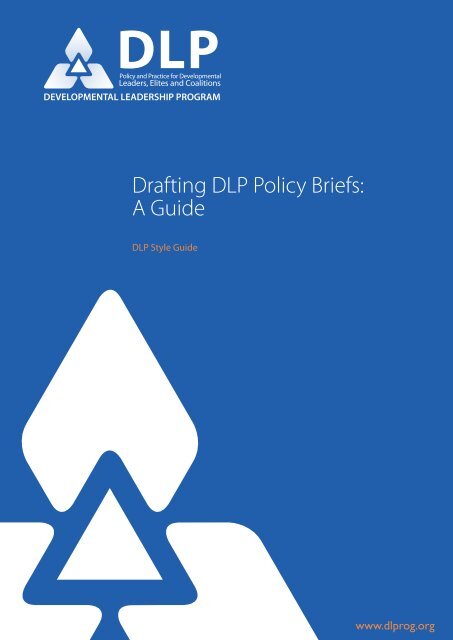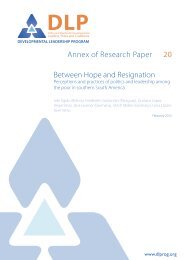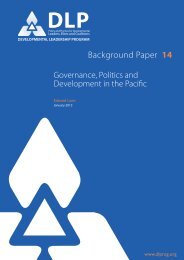Drafting DLP Policy Briefs: A Guide - The Developmental ...
Drafting DLP Policy Briefs: A Guide - The Developmental ...
Drafting DLP Policy Briefs: A Guide - The Developmental ...
- No tags were found...
You also want an ePaper? Increase the reach of your titles
YUMPU automatically turns print PDFs into web optimized ePapers that Google loves.
<strong>DLP</strong><strong>Policy</strong> and Practice for <strong>Developmental</strong>Leaders, Elites and CoalitionsDEVELOPMENTAL LEADERSHIP PROGRAM<strong>The</strong> <strong>Developmental</strong> Leadership Program (<strong>DLP</strong>)is an international policy initiative informed bytargeted research and directed by an independentsteering committee. <strong>DLP</strong> is supported by a globalnetwork of partners and currently receives its corefunding from the Australian aid program.<strong>The</strong> views expressed in this publication are thoseof the author(s) and do not necessarily representthose of the Australian Government or any of<strong>DLP</strong>’s other partner organisations.
1<strong>Drafting</strong> <strong>DLP</strong> <strong>Policy</strong> <strong>Briefs</strong>: A <strong>Guide</strong><strong>Policy</strong> briefs will be flagship publications for <strong>DLP</strong>. Most policy briefs will be written by <strong>DLP</strong> researchers,though in some circumstances we may commission them from experts in partner organisations. Thisguide outlines the purpose and suggested structure for a <strong>DLP</strong> policy brief. A design template is attached.If you wish to produce, or suggest ideas for, <strong>DLP</strong> policy briefs, please email a one-paragraph summary ofyour idea to <strong>DLP</strong>’s Program Director (tbc) and Adrian Leftwich (adrian.leftwich@york.ac.uk).What is a policy brief?A policy brief is a concise standalone document focussing on a particular issue requiring policy attention.See the end of this guide for link to a good example.A policy brief:• Explains and conveys the relevance and/or urgency of an issue• Presents policy recommendations around the issue• Gives evidence to support the reasoning behind the recommendations• Points the reader to additional resources on the issues• Can help to bridge the gap between the research and policy communities(eg between specialistacademics and those with more general knowledge).Your target audience is:• Non-academic and non-specialist• Decision makers with varying levels of expertise; policy makers in country and globally; media lobbyists;pressure groups and CSOs – not the general public.Think about:• How much they know (or don’t) about the issue – write in clear simple language, avoid jargon andgive acronyms in full on first use in the text - for example:…the <strong>Developmental</strong> Leadership Program (<strong>DLP</strong>)• how receptive is your audience likely to be to your arguments?• what questions do they want answered?
2Planning your policy brief - key questions• What issue(s) does it discuss?• Why is it important?• What recommendations are you making?• Is a policy brief the right vehicle for your argument?Planning your policy brief - structure<strong>Policy</strong> briefs are short – 4 pages – and a maximum of 2500 words, which will be reduced if diagramsand other material are included, as recommended below. Do not feel that your brief must be close to2500 words. Shorter drafts are fine.Structure:• Executive statement: (100-150 words). Gives an overview of the purpose and overarching messageof the policy brief, catches the attention of the reader (usually written last). Here or in the introduction,establish your credibility. This is the section that will attract your readers: for more informationsee <strong>DLP</strong> – writing an executive statement• Introduction: (up to 200 words). Explains why this issue is urgent and/or important. Should makeyour audience want to continue reading.• Key messages: (usually 3, one brief sentence for each).• Methodology - but only if:• there was something unusual or even unique about your approach or• you need to establish a credible base for the recommendations that follow.• Results and conclusions:• have you constructed a logical line of argument for making your recommendations (below)?• objectivity – the author should feel free to express opinions but must identify those componentsthat are opinion-based• key evidence – focus on research or results that support the main argument of the brief• Recommendations or implications:• determine up to three key policy recommendations and/or implications• offer a summary with clear, strong and co-ordinated recommendations• ensure these are actionable (ie linked to specific policy processes, feasible in terms of policysteps to be taken)• References and useful links:• <strong>DLP</strong> uses ‘Harvard Style’ format for references – see Annex for a summary• ensure you link to any seminal work that’s directly relevant. This is also a good opportunityto link to any other relevant <strong>DLP</strong> work.• Author: the brief should demonstrate why the author is a credible messenger (eg, qualifications anddirectly relevant experience, links to prestigious organisations or other evidence).
3Author’s role in design and layout<strong>Policy</strong> briefs need to be visually engaging. Please help by:• proposing titles, headings, and a “standfirst” (the one line message that usually acts as a subtitle onthe brief and generates interest - though these may be changed by the editor)• indicating material for text boxes (eg for a brief case study, a checklist etc)• quotes (do you have approval to use any quotes?)• graphs and diagrams (they should illustrate a key point in your argument and we will need © andcredit details)• photographs (we will need © and credit details).As a rough guide, each table or figure you include will reduce the overall word count by 150 words. Forexample, if you include one graph and one diagram your maximum word count is 2200 words.Next steps and sign off:• Email your draft to <strong>DLP</strong>’s Program Director, Chris Wheeler (chris.wheeler@dlprog.org), and Driectorof Research, Adrian Leftwich (adrian.leftwich@york.ac.uk) to start the process of peer reviewand production.• If you are from outside <strong>DLP</strong>, remember to alert your line manager or other institutional manager, ifrelevant.ReferencesThis guide draws heavily upon:Knezovich, J. (2009) <strong>Policy</strong> briefs as a tool for development communication, London: Overseas DevelopmentInstitute. Access presentation at:http://www.slideshare.net/ODI_Webmaster/policy-briefs-as-a-tool-for-communicating-developmentresearchGood example of a policy briefWiggins , S and Levy, S. (2008) Rising food prices: A global crisis, London: Overseas Development Institute.See: http://www.odi.org.uk/resources/download/1009.pdf
4Annex: ‘Harvard Style’ format for references 1Please use ‘Harvard Style’, where the reference appears in the text in its short form and the full bibliographicdetails are provided in an alphabetical reference list at the end. This page shows the mostcommon formats. Harvard Style guides are available online.<strong>The</strong> format for the text mention is as follows:… as described in Smith and Jones (2007: 37-9) or… as proposed in Smith et al. (2006)Full bibliographic details are structured as follows:1. Author/editor, with last name first, followed by comma, first initial and full stop;2. Year of publication (in brackets);3. Full title of the publication in italics;4. Place of publication;5. Publisher, e.g., <strong>The</strong> <strong>Developmental</strong> Leadership Program;6. Pages cited, if relevant.Example: Smith, J. (2005) How Aid Works, London: <strong>The</strong> <strong>Developmental</strong> Leadership Program, pp 31-32.Smith, J. and Jones, M (eds) (2005) How Aid Works, London: <strong>The</strong> <strong>Developmental</strong> Leadership Program,pp 31-32.Citing from the internet<strong>The</strong> format is exactly the same as for publications (last name of the author/editor, followed by comma,first initial and full stop, year in brackets, full title of the publication in italics, place of publication, publisher,pages cited), with the addition of the URL on a new line and the date on which this was visited. Example:Smith, J. (2005) How Aid Works, London: <strong>The</strong> <strong>Developmental</strong> Leadership Program.http://www.odi.org.uk/publications/opinions/94_aid_sept04.pdf1 Hawke, A. (2009) ODI Style <strong>Guide</strong>, London. Overseas Development Institute (internal publication).
<strong>DLP</strong> PublicationsResearch Papers1. Jo-Ansie van Wyk (2009) “Cadres, Capitalists and Coalitions: <strong>The</strong> ANC, Business and Developmentin South Africa”.2. David Subudubudu with Patrick Molutsi (2009) “Leaders, Elites and Coalitions in the Developmentof Botswana”.3. Eduard Grebe with Nicoli Nattrass (2009) “Leaders, Networks and Coalitions in the AIDS Response:A Comparison of Uganda and South Africa”.4. Deborah Brautigam with Tania Diolle (2009) “Coalitions, Capitalists and Credibility: Overcoming theCrisis of Confidence at Independence in Mauritius”.5. Jo Beall with Mduduzi Ngonyama (2009) “Indigenous Institutions, Traditional Leaders and <strong>Developmental</strong>Coalitions: <strong>The</strong> Case of Greater Durban, South Africa”.6. Adrian Leftwich (2009) “Bringing Agency Back In: Politics and Human Agency in Building Institutionsand States”.7. Junji Banno & Kenichi Ohno (2010) “<strong>The</strong> Flexible Structure of politics in Meiji Japan”.Background Papers1. Adrian Leftwich & Steve Hogg (2007) “Leaders, Elites and Coalitions: <strong>The</strong> case for leadership andthe primacy of politics in building effective states, institutions and governance for sustainable growthand social development”.2. Adrian Leftwich & Steve Hogg (2008) “<strong>The</strong> Politics of Institutional Indigenization: leaders, etitesand coalitions in building appropriate and legitimate institutions for sustainable growth and socialdevelopment”.3. Heather Lyne de Ver (2008) “Leadership Politics and Development: A Literature Survey”.4. Heather Lyne de Ver (2009) “Conceptions of Leadership”.5. Adrian Leftwich & Steve Hogg (2010) “<strong>The</strong> Leadership Program: Overview & Objectives”.6. Adrian Leftwich (2010) “An Overview of the Research in Progress for the Leadership Program:<strong>Developmental</strong> Leaders, Elites and Coalitions”.7. Isabelle van Notten (2010) “Integrity, Leadership, Women’s Coalitions and the Politics of InstitutionalReform. Bringing Agency Back In. Mid-Term Workshop Report, Cape Town 25-26 May 2010”.8. Edward Laws (2010) “<strong>The</strong> ‘Revolutionary Settlement’ in 17th Century England: Deploying a PoliticalSettlements Analysis”.
<strong>DLP</strong><strong>Policy</strong> and Practice for <strong>Developmental</strong>Leaders, Elites and CoalitionsDEVELOPMENTAL LEADERSHIP PROGRAM<strong>The</strong> <strong>Developmental</strong> Leadership Program (<strong>DLP</strong>)addresses an imporant gap in internationalthinking and policy about the critical roleplayed by leaders, elites and coalitions in thepolitics of development. This growing programbrings together government, academic andcivil society partners from around the worldto explore the role of human agency in theprocesses of development. <strong>DLP</strong> will address thepolicy, strategic and operational implications of‘thinking and working politically’ - for example,about how to help key players solve collectiveaction problems, forge developmental coalitions,negotiate effective institutions and build stablestates.<strong>The</strong> <strong>Developmental</strong> Leadership ProgramE: info@dlprog.orgW: www.dlprog.orgwww.dlprog.org




